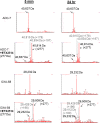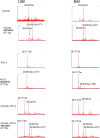Targeting Multidrug-Resistant Acinetobacter spp.: Sulbactam and the Diazabicyclooctenone β-Lactamase Inhibitor ETX2514 as a Novel Therapeutic Agent
- PMID: 30862744
- PMCID: PMC6414696
- DOI: 10.1128/mBio.00159-19
Targeting Multidrug-Resistant Acinetobacter spp.: Sulbactam and the Diazabicyclooctenone β-Lactamase Inhibitor ETX2514 as a Novel Therapeutic Agent
Abstract
Multidrug-resistant (MDR) Acinetobacter spp. poses a significant therapeutic challenge in part due to the presence of chromosomally encoded β-lactamases, including class C Acinetobacter-derived cephalosporinases (ADC) and class D oxacillinases (OXA), as well as plasmid-mediated class A β-lactamases. Importantly, OXA-like β-lactamases represent a gap in the spectrum of inhibition by recently approved β-lactamase inhibitors such as avibactam and vaborbactam. ETX2514 is a novel, rationally designed, diazabicyclooctenone inhibitor that effectively targets class A, C, and D β-lactamases. We show that addition of ETX2514 significantly increased the susceptibility of clinical Acinetobacterbaumannii isolates to sulbactam. AdeB and AdeJ were identified to be key efflux constituents for ETX2514 in A. baumannii The combination of sulbactam and ETX2514 was efficacious against A. baumannii carrying blaTEM-1, blaADC-82, blaOXA-23, and blaOXA-66 in a neutropenic murine thigh infection model. We also show that, in vitro, ETX2514 inhibited ADC-7 (k2/Ki 1.0 ± 0.1 × 106 M-1 s-1) and OXA-58 (k2/Ki 2.5 ± 0.3 × 105 M-1 s-1). Cocrystallization of ETX2514 with OXA-24/40 revealed hydrogen bonding interactions between ETX2514 and residues R261, S219, and S128 of OXA-24/40 in addition to a chloride ion occupied in the active site. Further, the C3 methyl group of ETX2514 shifts the position of M223. In conclusion, the sulbactam-ETX2514 combination possesses a broadened inhibitory range to include class D β-lactamases as well as class A and C β-lactamases and is a promising therapeutic candidate for infections caused by MDR Acinetobacter spp.IMPORTANCE The number and diversity of β-lactamases are steadily increasing. The emergence of β-lactamases that hydrolyze carbapenems poses a significant threat to our antibiotic armamentarium. The explosion of OXA enzymes that are carbapenem hydrolyzers is a major challenge (carbapenem-hydrolyzing class D [CHD]). An urgent need exists to discover β-lactamase inhibitors with class D activity. The sulbactam-ETX2514 combination demonstrates the potential to become a treatment regimen of choice for Acinetobacter spp. producing class D β-lactamases.
Keywords: Acinetobacter; DBO; ETX2514; beta-lactamases; beta-lactams; diazabicyclooctanone; diazabicyclooctenone; sulbactam; β-lactamase inhibitor.
Figures







References
-
- Durand-Reville TF, Guler S, Comita-Prevoir J, Chen B, Bifulco N, Huynh H, Lahiri S, Shapiro AB, McLeod SM, Carter NM, Moussa SH, Velez-Vega C, Olivier NB, McLaughlin R, Gao N, Thresher J, Palmer T, Andrews B, Giacobbe RA, Newman JV, Ehmann DE, de Jonge B, O'Donnell J, Mueller JP, Tommasi RA, Miller AA. 2017. ETX2514 is a broad-spectrum β-lactamase inhibitor for the treatment of drug-resistant Gram-negative bacteria including Acinetobacter baumannii. Nat Microbiol 2:17104. doi:10.1038/nmicrobiol.2017.104. - DOI - PubMed
-
- Blizzard TA, Chen H, Kim S, Wu J, Bodner R, Gude C, Imbriglio J, Young K, Park YW, Ogawa A, Raghoobar S, Hairston N, Painter RE, Wisniewski D, Scapin G, Fitzgerald P, Sharma N, Lu J, Ha S, Hermes J, Hammond ML. 2014. Discovery of MK-7655, a beta-lactamase inhibitor for combination with PrimaxinR. Bioorg Med Chem Lett 24:780–785. doi:10.1016/j.bmcl.2013.12.101. - DOI - PubMed
Publication types
MeSH terms
Substances
Grants and funding
LinkOut - more resources
Full Text Sources
Medical
Miscellaneous
